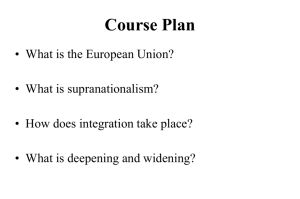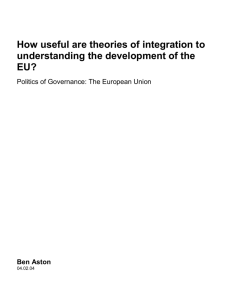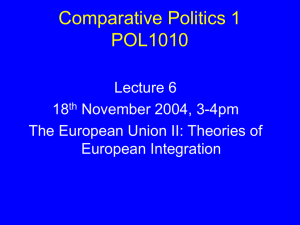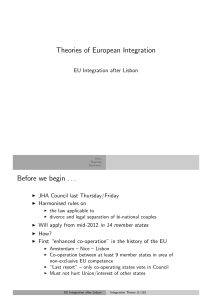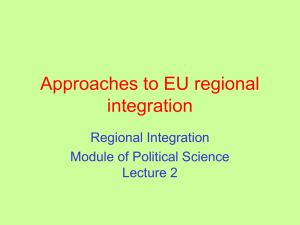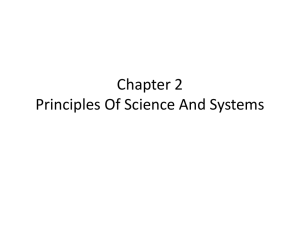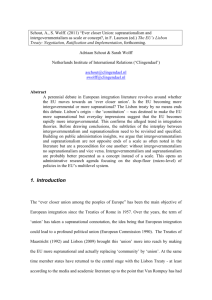Globalisation and Regionalisation I: general
advertisement
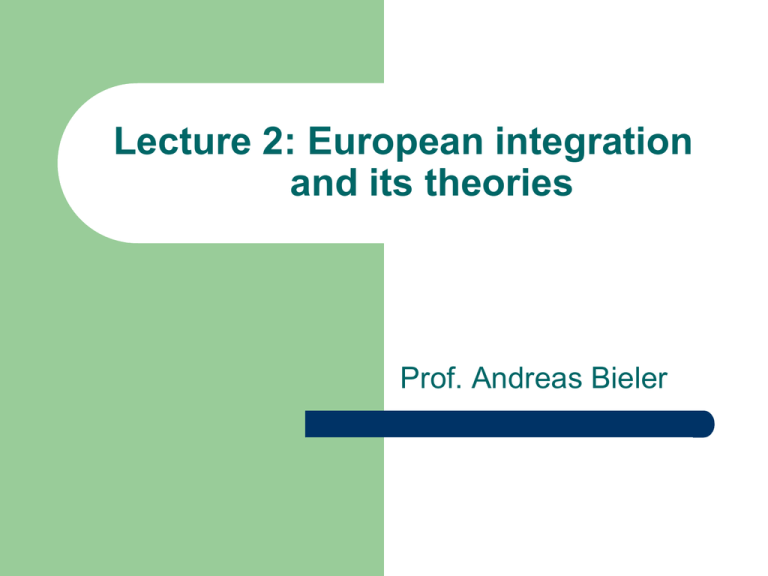
Lecture 2: European integration and its theories Prof. Andreas Bieler 1. Introduction puzzle of European integration, i.e. the transfer and pooling of sovereignty; the need of theories: the analysis and result is influenced by the theory adopted; theories of European integration: neofunctionalism and (liberal) intergovernmentalism. Structure of the lecture: the importance of theory; theories of European integration; evaluation and criticism of the theories of European integration; 2. The importance of theory: theories are necessary in that they provide concepts to produce ordered and, thus, meaningful observations; no statements about social phenomena are possible in a theoretical vacuum; theories are important in that they tell us which actors to look at and which phenomena to observe; theories influence the questions asked, the way research is carried out and, at least to some extent, has an impact on the research results; 3. Theories of European integration a) Neo-functionalism: start of integration: primacy of welfare issues better dealt with at supranational level; "Integration": ‘Political integration is the process whereby political actors in several distinct national settings are persuaded to shift their loyalties, expectations and political activities toward a new centre, whose institutions possess or demand jurisdiction over the pre-existing national states. The end result of a process of political integration is a new political community, superimposed over the pre-existing ones’ (Haas: 1958, p.16). Neo-functionalism "Spill-over": In its most general formulation, “spill-over” refers to a situation in which a given action, related to a specific goal, creates a situation in which the original goal can be assured only by taking further actions, which in turn create a further condition and a need for more action, and so forth (Lindberg: 1963, p.10). functional spill-over; Neo-functionalism: political spill-over; cultivated spill-over; automaticity of integration process; Empirical application of neo-functionalism: move from ECSC to EEC and Euratom in 1957 as functional spill-over; acceleration of timetable to set up common market in early 1960s due to pressure from industrialists, i.e. political spill-over; halt of European integration in 1965: de Gaulle’s empty chair crisis; Problems of neo-functionalism: spill-over implies an inevitable, teleological process of further integration along an objective economic rationality; European integration explained through emphasis on internal dynamics, while wider structure is neglected; b) Intergovernmentalism: core concepts derived from (neo-) realism: (1) states as only important actors; (2) anarchic international system; and (3) distribution of capabilities as main explanatory variable; Hoffmann: logic of diversity in ‘high politics’ (e.g. defence policy, foreign policy) is contrasted with logic of integration in ‘low politics’ (e.g. welfare issues); convergence of national preferences as precondition for European integration. Intergovernmentalism: application to start of European integration: bipolar structure made security concerns between Western European countries obsolete; Problems: (1) neglect of domestic politics; and (2) why was there a transfer and pooling of sovereignty since mid-1980s? Intergovernmentalism: application to start of European integration: bipolar structure made security concerns between Western European countries obsolete; Problems: (1) neglect of domestic politics; and (2) why was there a transfer and pooling of sovereignty since mid-1980s? c) Liberal Intergovernmentalism: Moravcsik. liberal theory of national preference formation; intergovernmentalist analysis of inter-state relations; extended version of regime theory; Liberal intergovernmentalism – application: Internal Market programme in 1985: new domestic convergence around neo-liberal economics: due to a change in government composition (Cameron); changing international structure, where USA and Japan had been more successful at overcoming the economic recession of the 1970s; Liberal intergovernmentalism – problems: transnational actors such as TNCs, having played an important role, cannot be taken into account; Commission/Delors were crucial in the coming about of the Internal Market programme; wrong emphasis on inter-state negotiations, overlooking role of agenda setting and ratification processes; Integration theories – which way forward? Combination of neo-functionalism and state-centric approaches cannot offer a way out. Solution: both approaches are valid as long as they are seen with their limitations; (liberal) intergovernmentalism: good for analysis of negotiations; Neo-functionalism: good for analysis of (transnational) interest groups and supranational institutions;
